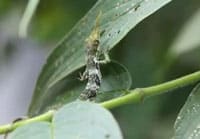Camouflage could be reason why Anolis proboscis hasn't been seen in the wild since the 1960s.
The Proboscis anole (Anolis proboscis), described as the unicorn of anoles because of the horn that protrudes from the male's head, has been "rediscovered" after not being seen in the wild for more than 40 years. A photograph of one was taken in 2005 by bird-watching tourists in Ecuador as it tried to cross a road. That photograph ended up on the Internet and onto the computer screen of Jonathan Losos, a Harvard University professor and the university's curator of herpetology. Losos was conducting research for a book that he was writing on anoles at the time he saw the image.
Other sightings of this seemingly elusive species were reported, and a team was assembled and led by associate professor Steven Poe with the University of New Mexico to seek out the anole. The team traveled to Ecuador in 2009 to try and locate the species in the wild. According to the Harvard Gazette, Poe, an associate of Harvard’s Museum of Comparative Zoology, was able to locate the species at night and observed some of its habits and physical characteristics. The lizard is six inches long and sleeps on the ends of tree branches that are typically 20 to 50 feet high, Poe told the Gazette. Poe's team also determined that the female did not sport a horn, an observation that was supported in a paper written in 2010 by scientists from Ecuador who captured and examined several specimens. The horn is not a stationary bony structure, like that of other horned lizards, but is movable, which adds a bit of mystery as to the purpose of the horn.
Because Poe's observations were conducted primarily at night, there was little record of the lizard's daytime activities, so Losos assembled a team in 2010 in an effort to obtain data on the lizard's daytime activities, the Gazette reported. The lizard, Losos' team determined, moves very slowly and blends well into the vegetation. It also stays about 10 to 20 feet off the ground during the day. It resides at the ends of tree branches that have a lot of foliage, staying well camouflaged. The extremely well camouflaged characteristics of the lizard, as well as its very slow movements may explain why the species hasn't previously been spotted in the wild sinin more than 40 years.
“Having observed them in the wild, it’s easy to understand why no one has found them for more than 40 years,” Losos told the Gazette. “It’s because it’s almost impossible to find them if you know what you’re looking for. Ultimately, we ended up finding only two or three during the day.”
Losos will continue research on the lizard, with hopes of studying its evolution and how it evolved in the Caribbean. Specifically, Losos wants to determine why the male of this particular species retains a horn on its head. He says the Proboscis anole is a dead ringer for the twig anole except for the horn. Both species live in the same habitat in the Caribbean and move the same way.


